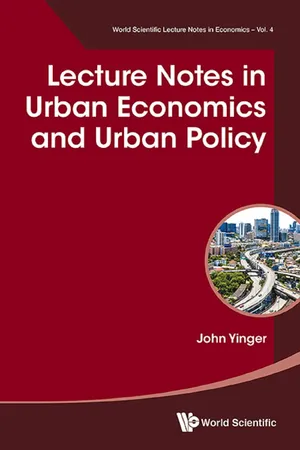
- 644 pages
- English
- ePUB (mobile friendly)
- Available on iOS & Android
About This Book
-->
Lecture Notes in Urban Economics and Urban Policy provides a wide-ranging introduction to urban economics and urban policy by Professor John Yinger, one of the world's leading scholars in urban economics. It draws on his extensive teaching and publication record to provide detailed lecture notes for both a PhD level course in urban economics and a master's level course in urban policy. Both the US and the world populations are becoming more and more urbanized, and these notes are designed to help scholars learn and teach about the factors that determine urban residential structure and that lead to urban problems such as inadequate housing, concentrated poverty, an inequitable distribution of local public services, racial and ethnic discrimination in housing, and traffic congestion. Although these notes focus on the US, many of the lessons in the notes apply to other countries as well. They also draw on Professor Yinger's extensive teaching experience and publication record in urban economics and should prove useful to many scholars who want to teach about or study urban areas.
-->
--> Contents:
- Urban Economics:
- The Basic Urban Model 1: Assumptions
- The Basic Urban Model 2: Solutions
- The Basic Urban Model 3: Comparative Statics
- More General Treatment of Housing Demand
- Estimating Housing Demand
- The Urban Transportation System
- Multiple Worksites and Full Labor Markets
- Household Heterogeneity
- Testing Urban Models
- Neighborhood Amenities
- Bidding and Sorting: The Theory of Local Public Finance
- Property Tax Capitalization
- Hedonic Regressions
- School-Quality Capitalization
- Housing Discrimination
- Notes Based on: "Now You See It, Now You Don't: Why Do Real Estate Agents Withhold Available Houses from Black Customers?"
- Homeownership Gaps Between Ethnic Groups
- Residential Segregation: Measurement, Causes, Consequences
- Mortgage Markets and Predatory Lending
- Mortgage Discrimination
- Urban Policy:
- Introduction
- Evaluating Social Programs
- Housing Concepts, Household Bids
- Household Sorting and Neighborhood Amenities
- Neighborhood Change
- Overview of Housing Markets
- Housing Problems and Federal Housing Programs
- Homelessness
- Race and Ethnicity, Prejudice and Discrimination
- Housing Discrimination and Its Causes
- Residential Segregation: Measurement, Causes, Consequences
- Mortgage Markets and Predatory Lending
- Discrimination in Mortgage Lending
- Poverty: Concepts and Evidence
- Concentrated Poverty
- Welfare Programs and Principles of Welfare Policy
- The New World of Welfare Policy
- Urban Labor Markets
- Human Capital Programs to Promote Community Development
- Financial Capital Programs to Promote Community Development
- Key Issues in Studying Urban Crime
-->
--> Readership: Students and academics interested in urban economics and urban policy. -->
Keywords:Urban Economics;Urban Policy;Local Public Finance;Racial and Discrimination in HousingReview: Key Features:
- The lecture notes in this book cover an extremely wide range of topics in urban economics and urban policy, from mathematical models of urban spatial structure urban problems, such as poverty and discrimination
- These notes draw on the extensive teaching and research record of Professor John Yinger, one of the world's leading urban economists
- These notes are a wide-ranging resource for teachers and scholars in the fields of urban economics and urban policy
Frequently asked questions
Information
Part 1
Urban Economics
Lecture 1
The Basic Urban Model 1: Assumptions
1.Origins of Urban Economics
1.1.von Thünen
1.2.von Thünen’s Model

1.3.Alonso



1.4.Mills and Muth


2.Key Assumptions of a Basic Urban Model
2.1.Urban Models
2.2.Key Assumptions
Table of contents
- Cover Page
- Title
- Copyright
- About the Author
- Contents
- About the Author
- Introduction
- Part 1 Urban Economics
- Part 2 Urban Policy
- References
- Index